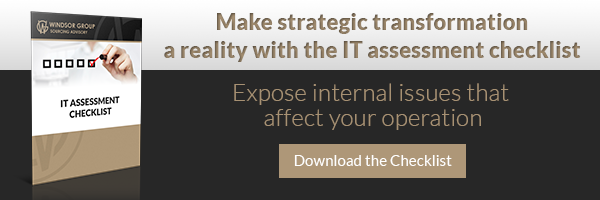 Conducting an IT infrastructure assessment can reveal important information about your company’s ability to face the future and function at peak performance while you’re getting there. What you learn will help you sidestep mistakes that could otherwise cause significant expense and headaches and derail your strategic plans.
Conducting an IT infrastructure assessment can reveal important information about your company’s ability to face the future and function at peak performance while you’re getting there. What you learn will help you sidestep mistakes that could otherwise cause significant expense and headaches and derail your strategic plans.
Consider these four problems your assessment might uncover:
1. You may be closer to a functionality meltdown than you think.
You know your legacy systems are getting older. If they aren’t causing glitches as you implement new applications or other technologies now, they soon will be. Meanwhile, your top-level IT staff – the ones who know your legacy systems like the backs of their hands – are also nearing retirement. Finding the right people to replace them is problematic at best.
You’re rightly proud of your company’s growth and global position. But has your disaster recovery plan kept pace? Is it still capable of assuring business continuity, in the timeframe you require? With recent growth in workforce mobility, data volumes, etc. many companies are also facing the need to comprehensively rethink IT procedures and policies so they reflect current usage and better prepare the company to move into the future.
An IT infrastructure assessment will pinpoint these gaps to show how close you really are to experiencing significant disruptions or diminished productivity with your current systems, and whether those systems are leaving you vulnerable to too-little-too-late disaster recovery.
2. True current TCO is higher than you thought.
No doubt you have a perfectly clear understanding of the specific expenses that directly relate to hardware, software, daily IT operations, labor, etc. But when you compute your “total” cost of ownership, are you also considering indirect costs such as corporate-level HR allocations, physical space and other facilities costs, depreciation and amortization?
Without identifying every expense associated with your IT operations, you don’t know your true TCO. An IT infrastructure assessment will fill in the picture so you can realistically and fully evaluate potential alternatives.
And as a corollary detail, are you sure you’re getting the maximum productivity output from your current systems? An IT infrastructure assessment will help you clearly see total value as well as total cost.
3. What you need most isn’t what you thought you needed most.
How closely aligned are your IT goals and your overall business goals – both long-term and near-term? Assuming that you can simply expand upon whatever you have in place now as you grow could be a dangerous strategy. What if an opportunity arises that takes you in a different direction? Will you still be able to flex with that smoothly, without incurring unforeseen costs, dips in service levels or quality?
An IT infrastructure assessment gives you the baseline data you need to identify where you stand and which IT changes will provide the efficiency and agility necessary to meet corporate as well as IT goals.
4. You aren’t using your IT personnel as effectively as you could be.
Assessing your workforce optimization should be part of your IT infrastructure assessment. There could well be tasks you can automate or outsource, or eliminate altogether, to make more effective use of your highly-skilled IT staff while also reducing costs and overall risk.
You didn’t grow your enterprise to its current successful position by ignoring vital decision-making data. Conducting an IT infrastructure assessment can ensure you have all the data you need to make mission-critical technology decisions, whether they’re in-house adjustments or wholesale migration to outsourced, cloud-based services and applications.
Photo credit: Alaskan Dude via Flickr


